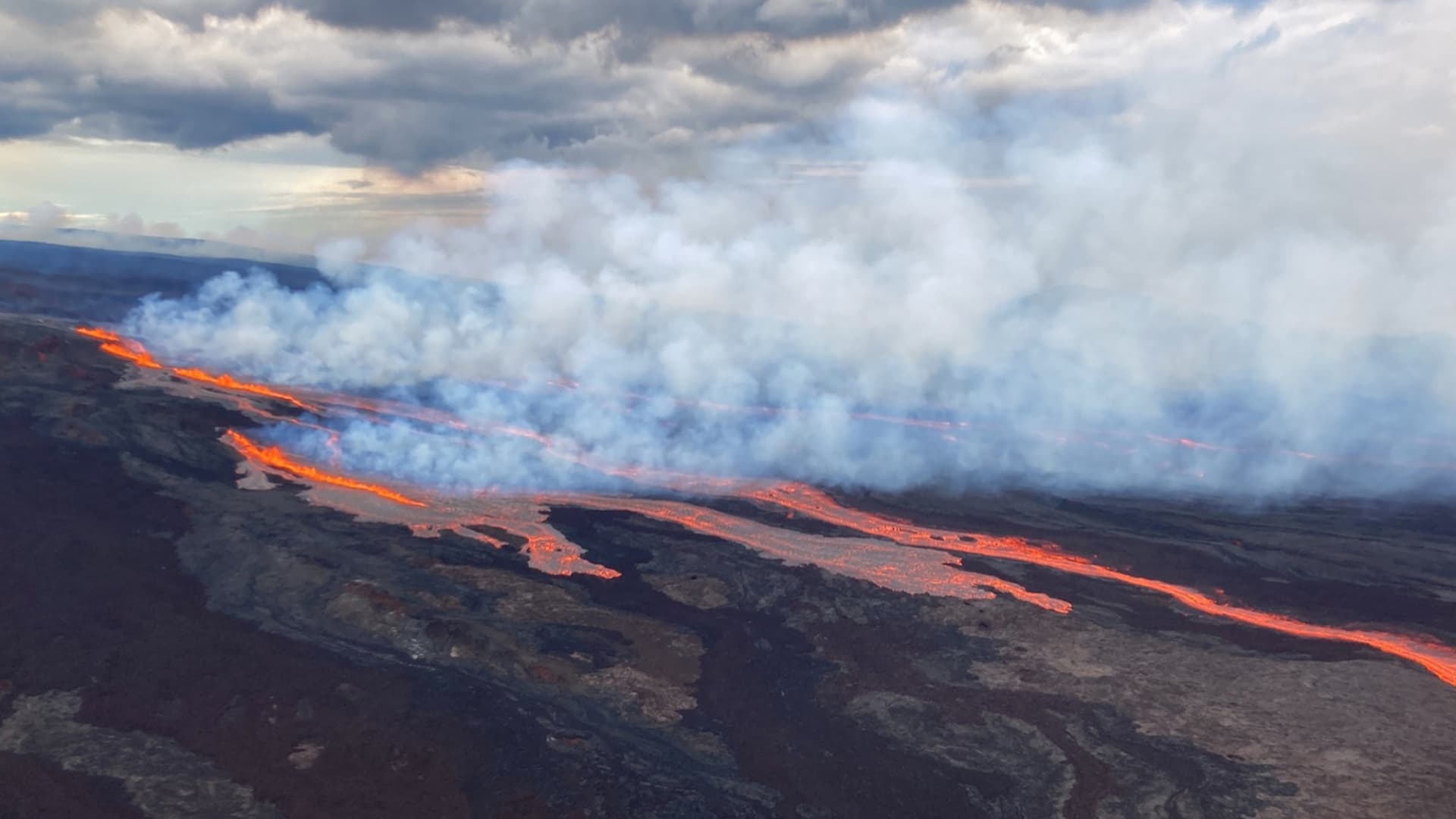World’s largest active volcano, Mauna Loa, erupts in Hawaii

In this aerial photo released by the U.S. Geological Survey, the Mauna Loa volcano is seen erupting from vents on the Northeast Rift Zone on the Big Island of Hawaii, Monday, Nov. 28, 2022.
U.S. Geological Survey via AP
The world’s largest active volcano has erupted in Hawaii for the first time in nearly four decades, officials said.
Mauna Loa erupted at 11:30 p.m. local time Sunday (4:30 a.m. ET Monday), the U.S. Geological Survey said. It was the first eruption since 1984, according to its Hawaii Volcano Observatory daily update.
The eruption began in Moku’?weoweo, the summit caldera of Mauna Loa, inside Hawaii Volcanoes National Park, the agency said, as it upgraded the volcano’s alert level from an “advisory” to a “warning.”
“At this time, lava flows are contained within the summit area and are not threatening downslope communities,” the USGS said in a news release. “Winds may carry volcanic gas and possibly fine ash and Pele’s hair downwind,” it said, referring to a type of lava.
Residents at risk from Mauna Loa lava flows were advised to “review preparedness and refer to Hawai’i County Civil Defense information for further guidance.”
“Based on past events, the early stages of a Mauna Loa eruption can be very dynamic and the location and advance of lava flows can change rapidly,” the agency warned. It said that if the eruption remains in Moku’?weoweo, lava flows would most likely be contained. “However, if the eruptive vents migrate outside its walls, lava flows may move rapidly downslope,” it said.
The most recent eruption followed weeks of warnings from officials that an eruption was possible given a recent spike in earthquakes at the volcano’s summit and that residents of the Big Island should be prepared to evacuate, NBC affiliate KHNL of Hawaii reported.
More from NBC News:
The USGS previously said that “heightened unrest” began in mid-September, when earthquakes beneath the summit increased from 10 to 20 per day to 40 to 50 per day. That unrest prompted Hawaii Volcanoes National Park to close the summit backcountry until further notice, it reported.
Ken Hon of the Hawaiian Volcano Observatory had said the earthquakes mainly occurred due to the weight of the mountain slowly sliding toward the ocean, KHNL reported.
In the weeks leading up to the eruption, residents had gathered in the towns of Pahala and Ocean View in October to discuss their concerns about county officials’ plans if an eruption were to unfold, it reported.
Hawaii’s civil defense agency also held meetings across the island to help residents prepare for a possible emergency, The Associated Press reported.
The volcano, whose name means “Long Mountain,” covers half of the island, according to the USGS. Prior to its most recent eruption, it erupted 33 times, beginning in 1843, making it among the world’s most active volcanoes. It is one of six volcanoes in the state of Hawaii, according to the agency.
FILE PHOTO: The Mauna Loa volcano on the island of Hawaii is shown in this March 25, 1984 handout photo provided by the U.S. Geological Survey, and released to Reuters on June 19, 2014.
Handout | Reuters
About half of those past eruptions remained in the summit region —which rises about 55,700 feet above its base, according to the USGS — and most others migrated from the summit into one of the rift zones, producing lava flows that covered broad regions on the volcano’s lower slopes.
“Hawaiian lava flows have rarely caused human fatalities, but they can cause extensive damage by covering, burning, and crushing anything in their paths, or starting secondary fires,” according to the agency, which adds that interactions between water and lava “can also sometimes be explosive in coastal environments.”
When the volcano’s northeast flank erupted in 1984, residents had time to prepare, as the eruption occurred in a “higher slope area” and took longer for the lava to travel towards the town of Hilo — the town located in the island’s northeast region and home to the Hilo International Airport — former Hawaii County Mayor Harry Kim, who was the civil defense administrator at the time, told KHNL. That eruption lasted three weeks, according to the USGS.